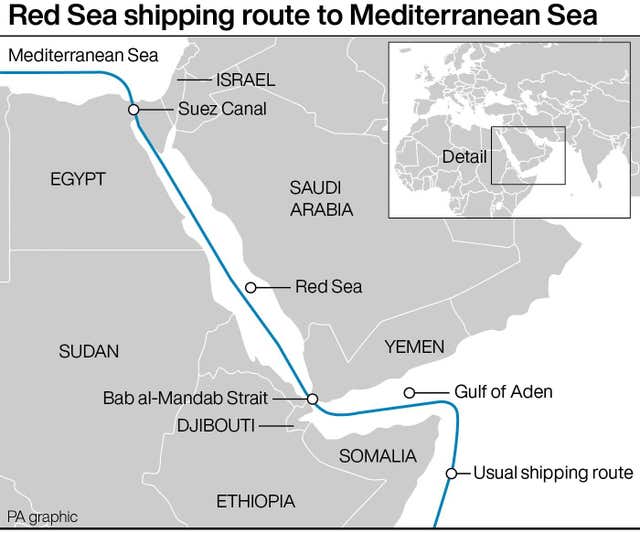
Ship traffic through the Suez Canal plunged by two thirds at the start of the month, according to new data which shines a light on the impact of disruption in the Red Sea on global trade amid heightened geopolitical tensions.
Ships crossing through the waterway dropped by 66% in the first week of April, compared with the same period last year, the Office for National Statistics (ONS) said.
The Suez Canal is an important and busy trade route for ships travelling between Asia and Europe, often carrying commodities like oil and natural gas.
The Bab-Al Mandab, which is also a gateway to and from the Red Sea, showed a 59% decrease in crossing volumes over the same period.
The ONS analysed the volume of maritime crossings using technology which tracks the position of cargo ships every few seconds.
The stark figures shed light on the impact of a period of disruption in the Red Sea since the escalation of conflict in the Middle East.

Container ships along the key trade routes have been repeatedly attacked since November.
Iran-backed Houthi rebels are behind the attacks in what they say is a campaign of solidarity with Palestinians in Gaza amid the Israel-Hamas conflict.
It has forced some ships to re-route around Africa via the Cape of Good Hope, a much lengthier journey which has driven up shipping costs and caused delays.
The data showed that the flow of ship crossings around the Cape of Good Hope started to pick up in December, and by the second week of February it was more than double the volume from the same week in 2023.
The ONS said the figures align with widely-reported maritime disruption in the Middle East.
Meanwhile, the Strait of Dover was the busiest of the six maritime passages it analysed, with on average around 1,300 ships crossing the passage per week in 2023.
Cargo ships accounted for the largest proportion of ships going through the route, at 50%.


Comments: Our rules
We want our comments to be a lively and valuable part of our community - a place where readers can debate and engage with the most important local issues. The ability to comment on our stories is a privilege, not a right, however, and that privilege may be withdrawn if it is abused or misused.
Please report any comments that break our rules.
Read the rules hereLast Updated:
Report this comment Cancel